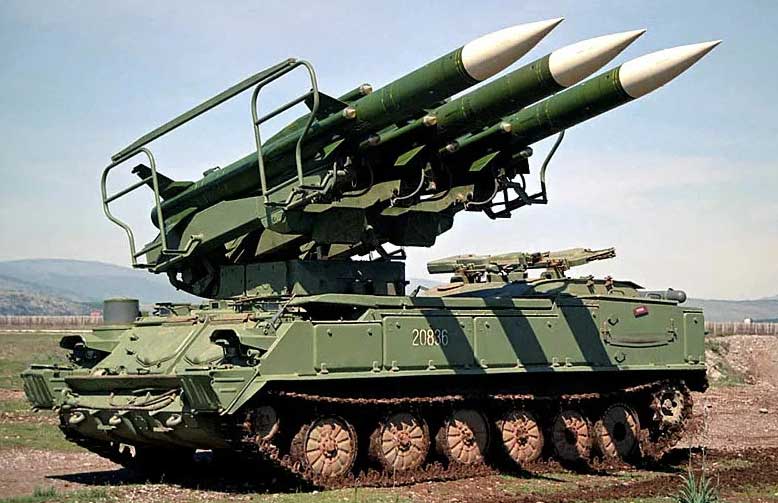Авторизация
Сейчас на сайте
Счетчики
Rebirth of KUB
Rebirth of KUB
The Ulyanovsk Mechanical Plant, in partnership with other enterprises, offers upgrades to the Kub (Kvadrat) ADM systems to raise their combat efficiency to a higher level.
Developed by the Tikhomirov Instrument Making Research Institute, the Kub army air defense missile (ADM) system entered service with the Soviet Army in 1966. In 1967, the Ulyanovsk Mechanical Plant (UMP) launched its mass production. Deliveries of the export version of the Kub ADM system, dubbed Kvadrat, began in 1971.
Considering its design features and operational capabilities, Kub was one of the most effective ADM systems in the world at that time. The system is comprised of two major components: a surveillance and guidance vehicle (SGV) outfitted with target detection and tracking radars (TDTR) that supply the required missile targeting data, and a self-propelled launch vehicle (SPLV) carrying three missiles.

Each missile is controlled via a radar homing head operating in response to a continuous signal generated by a specific transmitter incorporated in the target tracking radar and emitted by the radar antenna.
A battery of Kub ADM missiles consists of one surveillance and guidance vehicle and four launch vehicles carrying 12 missiles to successively engage targets.
To reduce the time required to make the ADM system fully operational from march, it employs an electronic subsystem providing for the relative orientation of combat elements and transmission of targeting data to missiles. The self-propelled tracked chassis on which the ADM system is mounted features cross-country capability, speed and other characteristics equal to those of a battle tank. This enables the ADM system to move within battle formations, including tank and mechanized units. Kub engages air threats flying at speeds of up to 600 m/s out to about 20 km in any direction at altitudes from 0.2 to 7 km. The system's time to action from march does not exceed 5 minutes. The system can be shipped by any type of transport.
Kub was used in action during the 1973 Middle East war, when a considerable number of Israeli combat aircraft were shot down, contributing significantly to the termination of the conflict. Foreign specialists invariably maintain that this system is highly effective, reliable and durable. The experience gained in action indicates that some of the system's performance characteristics can and should be substantially improved. Under the Defense Ministry's Directive, a series of upgrades have been made to the system. Their purpose was mainly to broaden the system's target engagement envelope, enable it to engage new classes of air threats, as well as increase resistance to jamming and enhance reliability. As a consequence, the maximum effective range has been increased from 20 to 24 km, the maximum engagement height has been increased from 7 to 14 km, and the minimum engagement height of 100-200 m has been reduced to 30-50 m. The minimum target engagement range of 6-8 km was reduced to 3-4 km. Moreover, the ability of the system to counter targets maneuvering at 7 to 8 g has also been expanded.
To back up the target tracking system, a TV-optical tracker was introduced in the surveillance and guidance vehicle and provision was made for timed and intermittent radar operation modes. Due to the introduction of these innovations, the ADM system's resistance to jamming and ability to survive anti-radiation missile attacks have been enhanced. In the period between 1967 and 1983, over 500 Kub ADM systems were manufactured. They entered service with the Soviet Army and with the armies of 22 other states worldwide. Kub is still operational, to its users' advantage. Recent checks carried out jointly by the Russian and foreign specialists have indicated that the ADM system has a remaining service life of at least 10 years. For even longer service, another upgrade has been made to this system in response to the requests of foreign customers. Under this upgrade program a new digital moving target indication (MTI) system has been developed. Built around vacuum storage tubes, the old MTI system was extremely complex, required multiple adjustments, and was one of the least reliable systems of the surveillance and guidance vehicle.
Built around state-of-the-art electronics, the digital MTI system features higher clutter rejection and useful signal transmission characteristics. Moreover, it requires no adjustment in operation and its reliability is much higher than that of its predecessor. Another upgrade is related to the development of a transmitting device for the continuous emission channel featuring a wider operating range and 12 (instead of six) homing head illumination letter-designated frequencies. In intense air attacks this innovation permits simultaneous use of 12 Kub ADM systems and enhances the missile's radio command link resistance to jamming. The third direction in which the Kub system upgrade efforts were concentrated was to develop an objective control system to assess the state of the launch vehicle and evaluate the data furnished to it by the SGV and the data sent to the missile prior to its launch. All information is recorded on the disk and can easily be interpreted. Developers also created a system tasked to control the entire target illumination section of the continuous emission channel, for which purpose a reference homing head was arranged in a separate van mounted on a vehicle chassis. And, finally, the fourth direction encompassed development of workstations to check and repair transmitting units, power sources, MTI and synchronization systems, etc. This ADM system upgrade program has been fulfilled successfully.
Since 1969, concurrently with the above-mentioned minor upgrades, the Instrument Making Research Institute has been conducting extensive research into novel principles for a second-generation ADM system design. Various types of radar signals have been studied, focusing on their noise immunity and processing flexibility. Methods of engaging several targets with one ADM system have been analyzed to incorporate early assessment of their engagement priority. Ways to optimize the missile radio command link have also been examined. At the same time, development of new electronic components was underway, including transmitter/receiver section microwave units, crystal and electromechanical filters, and miniature digital devices.
As a result of these efforts, innovative developments for the future Buk ADM system have been accumulated. The basic combat unit of the Buk ADM system is its self-propelled mount (SPM). A platform which can be traversed through 360o is mounted on a self-propelled chassis. An independent radar, TV-optical tracker, and launch unit with missiles are arranged on the platform. The SPM's radar can detect targets in a 120o sector in azimuth and 7 to 8o in elevation at ranges of up to 100 km. This radar emits the following types of signals: quasicontinuous, linear frequency-modulated pulse signal (LFMPS) compressed in the receiving section, a LFMPS continuous signal and QC signal to keep the homing head permanently active. Introduction in the surveillance channel of the quasicontinuous signal has made it possible to almost entirely eliminate the effects of passive noise and clutter on the operation of the radar. The linear frequency-modulated signal mode increases the system's resistance to jamming and makes it possible to obtain definitive target range and speed values. Introduction of the QC signal in the illumination channel and use of a specific curved flight path of the missile have made it possible to considerably enhance protection against high-potential jamming in the Doppler range. The SPM's equipment is based on modern components and manufactured using the latest technologies that have considerably enhanced its reliability and longevity.
The use of digital computers to process information furnished to the SPM has made the work of operators less laborious and reduced the vehicle's crew to three, compared with four in the surveillance and guidance vehicle. The crew's conditions were also made more comfortable. In addition to reduced noise and vibration levels and the installation of NBC protection facilities, each vehicle is equipped with an air-conditioning system, which is essential for the Middle East countries.
Two SPM versions were developed: the 9A38 featuring a unified launch unit, making it possible to use three Kub ADM missiles or three new missiles developed for the Buk ADM system, and the 9A310, featuring a launch unit carrying four Buk missiles. Although the yield and effective range of Buk ADM system missiles are greater than those of the Kub, the tail unit of the former is smaller and, therefore, more missiles can be carried by the vehicle. Concurrently with the development of the 9A38 version, provision was made for its integration into the earlier Kub ADM system. For this purpose the Kub's communications and relative orientation systems (used in the 2P25 launch vehicle) were installed in the SPM.
There are several reasons for integrating the 9A38 SPM in the Kub ADM system as a replacement for one of the 2P25 launch vehicles. First, the number of firing channels is doubled, while the cost of the 9A38 SPM is only 20 to 30 percent of the Kub ADM system. Second, resistance to jamming and protection against antiradiation missiles is considerably enhanced. Third, the latest Buk missiles can cope with a greater number of threat types and their engagement envelope is greater. Finally, when operated independently, the SPMs can be relocated promptly towards the most threatening directions. Due to the application of a target type identification system, which analyzes an echo signal spectrum, the SPM can effectively engage not only aerodynamic targets, but some types of ballistic targets, including hovering aircraft, too. The latest modifications made to the 9A310M1 SPM permit its use against surface and radio-contrast ground targets. The engagement envelope of the SPM armed with the Buk missile for targets with an echoing area above 1 m2 is:
- altitudes of 15 m to 22 km (instead of 25 m and 14 km by the Kub ADM system);
- ranges from 3 to 35 km at a speed of 830 m/s (instead of 4 to 24 km at 600 m/s by the Kub ADM system).
Comprehensive trials of the Kub ADM system equipped with the 9A38 SPM have been completed and it has entered service with the Russian Army under the code name Kub-M4.
Generally, the Kub ADM system can include even two, three or four launch vehicles. However, the capacity of the surveillance and guidance facilities make such configurations inefficient. It is more desirable that the loader-launcher (LL) developed for the Buk ADM system be integrated with the Kub ADM system complete with the SPM. The LL carries eight missiles: four kept in a ready-to-launch position and four stored in a load-carrying unit. The LL is equipped with a crane used to transfer the missiles onto the SPM or load them onto its own launch unit. Operating in conjunction with the SPM, the LL functions as an additional launcher and provides additional missiles. Integration of the SPM in the Kub ADM system requires minor modifications. The new qualities brought by the SPM to the Kub ADM system constitute the latter's rebirth.
Vyacheslav Abanin - Director of the Ulyanovsk Mechanical Plant
Yevgeny Pigin - Chief Designer, of thr Instrument Making Research Institute
Ardalion Rastov - Honorary Member of the Academy of Rocket and Artillery Sciences of the Russian Federation





Letzte Kommentare
Artikel
Fotos
Eigene Seiten